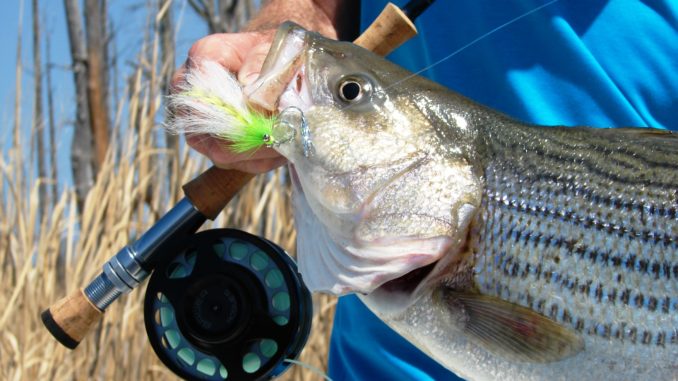
Hungry fish will hit swimbaits, stream flies — just about anything that swims.
A growing number of fishermen are aware of the striped bass in the Cape Fear, Northeast Cape Fear and Brunswick rivers around Wilmington during the winter, but there isn’t nearly as much recognition for those same fish as the weather and water warms from April through June.
However, Capt. Stuart Caulder of Gold Leader Fishing in Wrightsville Beach and other guides, say the post-spawn striper bite in the waters around Wilmington might be even more intense than the bite before they head upriver to spawn.
While he fishes in the Cape Fear and Brunswick, Caulder prefers targeting stripers in the Northeast Cape Fear. Whichever way he heads in the morning, it’s a short run from the Dram Tree Park Ramp beside the Cape Fear Memorial Bridge.
One late spring morning, Caulder headed up the Northeast Cape Fear between Wilmington and the I-140/US 17 bypass bridge, running only a few minutes before cutting his outboard and easing his trolling motor over to work in the direction of the bank.
Once within casting range, Caulder passed out medium-light spinning outfits rigged with soft-plastic jerkbaits on swimbait hooks — his standard set-up for Cape Fear stripers, whether it’s January or June.
Caulder instructed the fishermen in his party to cast to the bank and use a slow to medium-fast retrieve that includes two twitches and a pause as the lure is allowed to sink to the bottom, then another series of twitches and pauses. He said stripers will occasionally strike as the lure is being twitched, but most strikes would come on the fall.
Only a few casts into the trip, D.J. Struntz had a strike but didn’t hook up.
“That’s OK,” Caulder said. “Chunk it right back to the same place and see if he’s upset he didn’t get it and will hit stronger this time.”
Struntz cast several times before he had another strike, and this one was weak and slow. Caulder said it was definitely a striper, but he thought maybe it would take a while for the tide to reach the stage where the fish would start feeding aggressively.
“Most fishermen know we have stripers in the rivers around Wilmington during the winter, but not many know they are also here during the spring and even a little into the summer,” Caulder said. “They head upriver to spawn sometime in late March or April, and most fishermen think they’re gone. They are gone for three to five weeks, but when they return, they’re hungry, and I believe they are easier to catch. This is a good time for those interested to try them on flies.
“Depending on how quickly the water warms, these stripers will be active and feeding to some point in July,” Caulder said. “However, when they leave in the middle of the summer, they don’t show back up until the water cools in November or December.”
Caulder said he found the spring and summer stripers several years ago while fishing for redfish and trout well up the river — it was a dry year when the water was very salty all the way to above downtown Wilmington. He remembered seeing some baitfish scattering along the bank and thought redfish were chasing them until his first hookup produced a striper. He said he caught them mixed with redfish that day and thought it was probably a fluke, but the stripers continued to feed with the reds for several weeks. When he caught them again the next spring, he realized there might be a little more to it. Now, several years later — with the stripers showing every spring — that seems to be the case.
Caulder said the stripers are famished when they return from the trek upriver to spawn, and they feed heavily. Some even gorge themselves to the point their enlarged bellies make them appear ready to spawn again.
At the same time, the rivers are loaded with small menhaden and some mullet minnows that wintered there, and these are the prime forage for post-spawn stripers. Baitfish move into the small creeks and drains along the river as the tide rises, and they have to come out when it begins to fall. When the bait has to retreat back out into the river, the predators are waiting to feed. In addition to the stripers, red drum are there, plus occasional speckled trout, bass, gar and catfish.
As the rising tide neared its peak, the fish began to bite. The bite started slowly at first but built until it was pretty steady. In addition to the stripers, several redfish from just under-slot to upper-slot size joined the feeding party.
Caulder rigs his baits using a small loop knot that allows them to dart as naturally as possible when twitched and flutter seductively on the drop. He uses two feet of 20-pound fluorocarbon for leader, tied to the 15-pound super braid on his reel.
Just beyond halfway through the falling tide, the bite slowed again. The small creeks were mostly empty, and the water level had dropped enough that many of the stumps along the bank had become visible. Patches of grass that had been underwater were now also poking through.
The structure available to baitfish and predators in the rivers around Wilmington is obviously one of the things that make it so attractive to them. There is small cover, which appears to be tailor-made for baitfish, and many spots of larger structure that block the current and are ideal for stripers, redfish and other predators to hide out, within easy striking distance of any bait moving into or out of the marsh and creeks.
Caulder explained that the amount of rainfall in the area upstream from Greensboro to Fayetteville will determine exactly where the stripers set up shop. During times of drought in the Cape Fear basin, the saltwater in the lower river forges inland, and with it come the red drum and trout. After wet winters and springs, the influx of freshwater will push the red drum and trout downriver but generally won’t affect the stripers. In fact, a rainy spring keeps the river cooler, and the stripers stay a little longer.
Caulder said spring and early summer stripers around Wilmington are really worth the pursuit, but many days, he’s the only boat targeting them. When the reds and trout aren’t mixed in with them, they’re usually just a little ways downriver, and usually cooperate to allow fishermen to also put something in the boat that can be kept for dinner.
DESTINATION INFORMATION
HOW TO GET THERE/WHEN TO GO: Getting to Wilmington is easy. I-40 crosses North Carolina from west to east and terminates in Wilmington. US 74 and 421 also run west to east and end at Wilmington. US 17 is the best access from north or south. The launching ramp most convenient to downtown Wilmington is Dram Tree Park, just upstream of the Cape Fear Memorial Bridge (US 421/US76/US17B) off Castle Street. A public ramp on the Northeast Cape Fear in Castle Hayne is just off US 117/NC 133, and another is at Snow’s Cut on the ICW at Carolina Beach off US 421. Specific directions to these ramps can be found in the Boating Access section of the N.C. Wildlife Resources website at www.ncwildlife.org. Fishermen are learning that the post-spawn action from April through June can be surprisingly good.
EQUIPMENT PREFERENCES: Medium to medium-heavy spinning and baitcasting outfits in 7-foot lengths are perfect. Spool up with a super-braid line; Capt. Stu Caulder likes the Berkley Fireline Crystal for its sensitivity and lack of stretch, which helps him pull some fish out of cover. Big D.O.A. swimbaits and jerkbaits rigged weedless on swimbait hooks are the ticket, along with suspending lures such as MirrOlure’s MirrOdine 17MR and 27MR. Caulder will often troll with deep-diving plugs. The post-spawn is a great time to target stripers with fly-fishing equipment, specifically 9-weight rods and intermediate line. Large streamer flies in baitfish patterns are preferred — as long as they feature some chartreuse coloration. Chartreuse/white and chartreuse/blue are great color patterns.
ACCOMMODATIONS: The Best Western at the Coastline Convention Center (800-617-7732 or www.coastlineinn.com) has some dockage and is located in the prime striper fishing area. Other fisherman-friendly places include MainStay Suites, 5229 Market St., 910-392-1741, www.mainstaywilmingtonnc.com and Sleep Inn, 5225 Market St., 910-313-6665, http://www.sleepinnwilmingtonnc.com/. For more options, Cape Fear Convention and Visitors Bureau, 877-406-2356 or www.cape-fear.nc.us.
GUIDES/FISHING INFO: Capt. Stu Caulder, Gold Leader Fishing, 910-264-2674, www.goldleaderfishing.com. Tex’s Tackle and Bait, 910-791-1763, www.texstackle.com; Island Tackle and Hardware, 910-458-3049. www.islandtacklehardware.com. Also, see Guides and Charters in Classifieds.
CHARTS: GMCO Chartbook of North Carolina, 888-420-6277, www.gmcomaps.com; Capt. Segull’s Nautical Charts, 888-473-4855, www.captainsegullcharts.com.

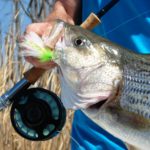
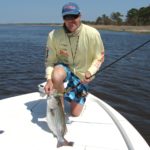
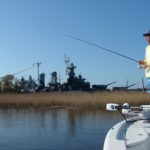
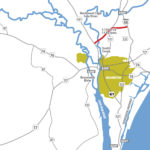




Be the first to comment